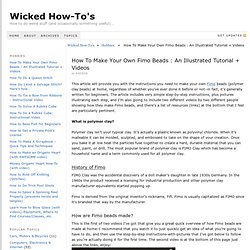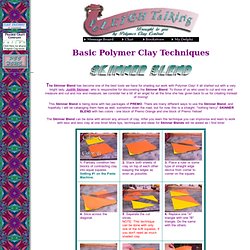

Eraser Clay Flower Cane. Canes (instructions & types) Www.sculpey.com/sites/all/themes/sculpey/img/Color_Mixing.pdf. How To Make Your Own Fimo Beads : An Illustrated Tutorial + Videos. This article will provide you with the instructions you need to make your own Fimo beads (polymer clay beads) at home, regardless of whether you’ve ever done it before or not–in fact, it’s generally written for beginners.

The article includes very simple step-by-step instructions, plus pictures illustrating each step, and I’m also going to include two different videos by two different people showing how they make Fimo beads, and there’s a list of resources (links) at the bottom that I feel are particularly pertinent. What is polymer clay? Polymer clay isn’t your typical clay. It’s actually a plastic known as polyvinyl chloride. When it’s malleable it can be molded, sculpted, and embossed to take on the shape of your creation. History of Fimo FIMO Clay was the accidental discovery of a doll maker’s daughter in late 1930s Germany.
Fimo is derived from the original inventor’s nickname, Fifi. Faux Turquoise Beads For A Unique Bracelet. An Old Food Processor Will Come In Very Handy For This Faux Stone Project: Right now I am working on the next set of polymer clay tutorials to add to the video library.

Due to popular demand, one of those videos is all about making faux turquoise beads. The technique is really fun… partly because it is so messy! You will need just a few chunks of clay, sand, paint and an old food processor. Actually, if you don’t have a food processor, that will be OK. Besides being useful for making faux stone beads like Turquoise, Coral, Lapis Lazuli and Granite, the food processor is also really handy for conditioning your polymer clay. If you would like to purchase tutorial videos on how to use a food processor with polymer clay, check out Back Issue Volume-003 in the members library. Polymer Clay Tools for Softening Clay Quickly. Vid #63: This polymer clay food processor technique makes dealing with hard clay a breeze: As described in a previous post, an old food processor makes an excellent polymer clay tool for conditioning, mixing, and chopping polymer clay.

Perfect when you have tired hands or other strength issues from carpal tunnel syndrome or arthritis. Conditioning How To – Polymer Clay Tools, Techniques and Instructions. @Michele: Hi Michele!

I hope some of the following helps! Glycerin I’m one of the Kato enthusiasts around here — and Kato should not be sticky! — but unfortunately I don’t have any glycerin to test how it behaves. I’d heard of using glycerin as a release agent with polymer clay, but not as a softener, so I did a bit of internet searching. Donna Kato worked with other clays before she developed her own brand, so unless she mentions a brand or you know the date of her comment it might not actually be referring to Kato clay. I hate to say it, but you might have to throw away the Kato that had glycerin added. Known Kato-Safe Softening Agents While I rarely want to soften Kato, the two softening agents I’ve used are: 1. 2. Clay Softening Techniques There are two techniques I use, depending on whether I can condition the clay or not. 1. 2. Is Conditioning Really that Important? Hmmmm… Let Me See… YESSSSS!!!

When you work with polymer clay, especially when making canes, it is very important that you first condition all of your clay to the same consistency. If one of your pieces is soft and mushy, while another is hard and crumbly, you are going to run into a whole bunch of frustrating problems. Make Polymer Clay Pendants and Flat Beads Smooth and Bubble Free. Make Polymer Clay Pendants and Flat Beads Smooth and Bubble Free Trapped Air in Your Polymer Clay Beads or Pendants Can Quickly Ruin a Piece of Jewelry: There are a few tricks that you can do to prevent air from getting into your clay.

Here are a few of them along with some tips for minimizing the problem if some bubbles do happen to show up: Baking Polymer Clay Pendants in a Ceramic Tile Sandwich. Baking Polymer Clay Pendants in a Ceramic Tile Sandwich.

What types of pigments are used to color the clays? Are they toxic? How do I repair cracks? How do I prevent cracking and breaking? Projects. Color Mixing · Polymer Clay. Mar Pantone releases colour forecasts every season and you see all the mediums and industries talk about them and discuss how to incorporate them.

Polymer clay is not an exception and some clayers are on the ball enough to provide recipes… Feb Yesterday I mentioned amethyst was something I have a fondness for. I’ve never been a huge purple lover but I have friends who are SERIOUSLY into their purple. Oct Polymer Clay Color Inspirations – Techniques and Jewelry projects for creating succesful palettes by Lindly Haunani and Maggie Maggio (RRP $21.95) This book will teach you everything you need to know about color palettes. Hi ladies (and gents?) Aug It’s true, I’m a Kato gal. Poking around Polymer Clay Daily tonight I ran across the Color Stripes blog. Is it wrong to love a blog, my heart is a-flutter? Jan Yes, I’m on a color kick this week! You might want to try these color mixing tricks to achieve different common color palette variations: Autumnal colors add ecru … Sep. Characteristics of polymer clays. PaperClay vs Cold Porcelain vs Polymer Clay. PoLEIGH Talking - Skinner Blend 1.
The Skinner Blend has become one of the best tools we have for shading our work with Polymer Clay!

It all started out with a very bright lady, Judith Skinner, who is responsible for discovering the Skinner Blend. To those of us who used to cut and mix and measure and cut and mix and measure, we consider her a bit of an angel for all the time she has given back to us for creating instead of mixing! This Skinner Blend is being done with two packages of PREMO. There are many different ways to use the Skinner Blend, and hopefully I will be cataloging them here as well, sometime down the road, but for now, this is a straight, "nothing fancy" SKINNER BLEND with two colors - one block of Premo Orange and one block of Premo Yellow! The Skinner Blend can be done with almost any amount of clay. All baked and ready to wear. Sculpey Clay Elephant.